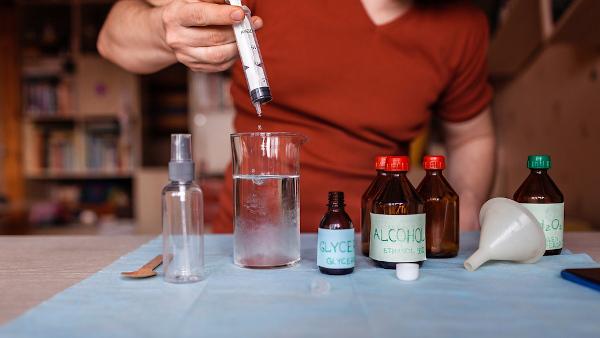O sticky appearance presented by some brands of alcohol gel is due to the new formulations created during the period of pandemic of Covid-19. Due to the health crisis situation, the use of antiseptics, especially alcohol gel 70% for its practicality, increased abruptly, and production had to adapt to meet this need worldwide. One of the problems with this large-scale manufacturing was the disposal of raw materials.
Soon, the carbopol started to run out, which is the thickening agent used in the manufacture of alcohol gel. In search of a solution for the lack of this substance, some industries started to use other types of thickeners, which was accepted by Anvisa (National Health Surveillance Agency), as long as it did not compromise the asepsis quality offered by the product.
Read too:Soap water or alcohol gel: which is the most effective?
Why did the alcohol gel get sticky?

O carbopol, thickener responsible for the viscous texture, is one of the raw materials of alcohol gel. With the increasing demand for the antiseptic, this reagent
it became scarce on the market, as a result, other types of thickener were used. As it was an emergency alternative, sensory quality was not prioritized when replacing the thickener, but the effectiveness of the final product in terms of disinfection.In addition to changing the thickening agent, another factor that attributes the sticky texture of 70% alcohol gel when used on the skin is the addition of additives with a moisturizing function, for example.
Original alcohol gel composition
Alcohol in gel is originally composed of:
70% alcohol%: this concentration can be obtained by diluting 99° GL alcohol in distilled or deionized water.
Carbopol: thickening agent that gives alcohol the appearance of a gel.
Triethanolamine: neutralizing agent to regulate the pH of the product.
See too: Five contact-borne diseases
Changes in the composition of alcohol gel
With the growing demand for alcohol gel, used as an essential item to combat the transmission of the new coronavirus, adaptations were necessary in the production and formulation of the product. As previously mentioned, the first raw material that was lacking for the production of gel antiseptics was the thickener carbopol, which motivated the creation of new formulations with reagents that could replace it. The alternatives are the most diverse, starting from homemade ones with the use of colorless gelatin and alcohol (in proportion of 70% alcohol 99° GL) to industrial formulations with other types of gelling agents, skin moisturizers and Perfumes.
During this period, several cases of illegal and adulterated production of antiseptic. In the state of Ceará, for example, a production in which 70% alcohol gel was made from stationary ethanol, cellulose ether (food thickener) and glycerin was seized. The risk, in this case, existed not only because of the absence of reagent quality control, as from the ethanol that came from automotive gas stations, which presents unhealthy additives, but also the risk in the form of storage, as it is a flammable material.

Increased production of alcohol in gel
Like worsening of the pandemic of Çovid-19, the use of alcohol in gel to combat the spread of virus, for cleaning hands and surfaces that have a lot of contact (objects, keys, wallets, doorknobs, etc.), grew suddenly. There was a increase in demand of the product and consequently an increase in production. To meet this need, changes were made in the economic and industrial sector.
On May 20, 2020, Anvisa released, temporarily, that companies in the sanitizing sector (products of cleaning), cosmetics and pharmaceuticals to produce antiseptics and sanitizers without the need for a permit prior. Companies that were not specific to the production of alcohol in gel have adapted to get around the moment of crisis and to meet the needs of the population.
An example of this was the cosmetics company Victoria Maxx, which, with the closing of stores precisely due to the pandemic, had a drop in demand for beauty products and readjusted to face the collapse: it started to produce alcohol in gel, reaching 5,000 tons per day, for sale and Donation. Another initiative to deal with the high demand for alcohol in gel was developed by the Federal Institute do Sul de Minas in partnership with the Federal Revenue Office in Poços de Caldas, which started to send alcoholic beverages seized for the institute where the product is treated and transformed into antiseptic.
by Laysa Bernardes
Chemistry teacher
Source: Brazil School - https://brasilescola.uol.com.br/quimica/por-que-o-alcool-em-gel-ficou-pegajoso.htm

